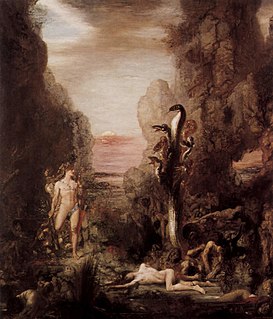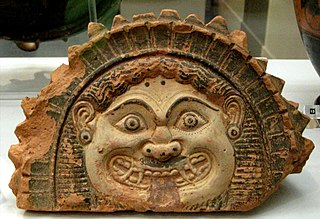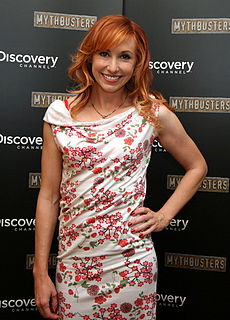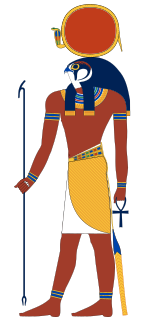
Athena or Athene, often given the epithet Pallas, is an ancient Greek goddess associated with wisdom, handicraft, and warfare, who was later syncretized with the Roman goddess Minerva. Athena was regarded as the patron and protectress of various cities across Greece, particularly the city of Athens, from which she most likely received her name. She is usually shown in art wearing a helmet and holding a spear. Her major symbols include owls, olive trees, snakes, and the Gorgoneion.

Artemis, in the ancient Greek religion and myth, is the goddess of the hunt, the wilderness, wild animals, the Moon, and chastity.

In ancient Greek religion and mythology, Demeter is the goddess of the grain, agriculture, harvest, growth, and nourishment, who presided over grains and the fertility of the earth. Her cult titles include Sito (Σιτώ), "she of the Grain", as the giver of food or grain, and Thesmophoros, "Law-Bringer", as a mark of the civilized existence of agricultural society.

Hera is the goddess of women, marriage, family, and childbirth in ancient Greek religion and myth, one of the Twelve Olympians and the sister-wife of Zeus. She is the daughter of the Titans Cronus and Rhea. Hera rules over Mount Olympus as queen of the gods. A matronly figure, Hera served as both the patroness and protectress of married women, presiding over weddings and blessing marital unions. One of Hera's defining characteristics is her jealous and vengeful nature against Zeus' numerous lovers and illegitimate offspring, as well as the mortals who cross her.

Inanna is an ancient Mesopotamian goddess associated with love, beauty, sex, desire, fertility, war, justice, and political power. She was originally worshipped in Sumer and was later worshipped by the Akkadians, Babylonians, and Assyrians under the name Ishtar. She was known as the "Queen of Heaven" and was the patron goddess of the Eanna temple at the city of Uruk, which was her main cult center. She was associated with the planet Venus and her most prominent symbols included the lion and the eight-pointed star. Her husband was the god Dumuzid and her sukkal, or personal attendant, was the goddess Ninshubur.

Ariadne, in Greek mythology, was a Cretan princess. She is mostly associated with mazes and labyrinths because of her involvement in the myths of the Minotaur and Theseus.

The Lernaean Hydra or Hydra of Lerna, more often known simply as the Hydra, is a serpentine water monster in Greek and Roman mythology. Its lair was the lake of Lerna in the Argolid, which was also the site of the myth of the Danaïdes. Lerna was reputed to be an entrance to the Underworld, and archaeology has established it as a sacred site older than Mycenaean Argos. In the canonical Hydra myth, the monster is killed by Heracles (Hercules) as the second of his Twelve Labors.
Áine is an Irish goddess of summer, wealth and sovereignty. She is associated with midsummer and the sun, and is sometimes represented by a red mare. She is the daughter of Egobail, the sister of Aillen and/or Fennen, and is claimed as an ancestor by multiple Irish families. As the goddess of love and fertility, she had command over crops and animals and is also associated with agriculture.

Mehet-Weret is an ancient Egyptian deity of the sky in ancient Egyptian religion. Her name means "Great Flood".

Korean mythology are the stories passed down by word of mouth over thousands of years on the Korean Peninsula and only written down in historical times. These stories serve as creation myths about the world and origin myths about nature or the social world. Korean myths are often localized and concern specific villages or clans.
In Slavic mythology, Zorya are the two guardian goddesses, known as the Auroras. They guard and watch over the winged doomsday hound, Simargl, who is chained to the star Polaris in the constellation Ursa Minor, the "little bear". If the chain ever breaks, the hound will devour the constellation and the universe will end. The Zoryas represent the Morning Star and the Evening Star.

In Greek mythology, Medusa was a monster, a Gorgon, generally described as a winged human female with living venomous snakes in place of hair. Those who gazed upon her face would turn to stone. Most sources describe her as the daughter of Phorcys and Ceto, though the author Hyginus makes her the daughter of Gorgon and Ceto. According to Hesiod and Aeschylus, she lived and died on an island named Sarpedon, somewhere near Cisthene. The 2nd-century BCE novelist Dionysios Skytobrachion puts her somewhere in Libya, where Herodotus had said the Berbers originated her myth, as part of their religion.

In narratology and comparative mythology, the monomyth, or the hero's journey, is the common template of a broad category of tales and lore that involves a hero who goes on an adventure, and in a decisive crisis wins a victory, and then comes home changed or transformed.

Kari Elizabeth Byron Urich is an American television host and artist, best known for her featured role on the Discovery Channel show MythBusters and Netflix's White Rabbit Project.

Virgo (♍), is the sixth astrological sign in the Zodiac. It spans the 150-180th degree of the zodiac. Under the tropical zodiac, the Sun transits this area on average between August 23 and September 22, and the Sun transits the constellation of Virgo from approximately September 16 to October 30. Individuals born during these dates, depending on which system of astrology they subscribe to, may be called Virgos or Virgoans. The symbol of the maiden is based on Astraea. In Greek mythology, she was the last immortal to abandon Earth at the end of the Silver Age, when the gods fled to Olympus – hence the sign's association with Earth.

Eye of the Beholder III: Assault on Myth Drannor is a 1993 role-playing video game and the sequel to Eye of the Beholder and Eye of the Beholder II: The Legend of Darkmoon.

Dorothy Milne Murdock, better known by her pen names Acharya S and D. M. Murdock, was an American writer who supported the Christ myth theory that Jesus never existed as a historical person and was rather a commingling of various pre-Christian mythologies, Sun deities and dying-and-rising deities.

Ra or Re is the ancient Egyptian deity of the sun. By the Fifth Dynasty in the 25th and 24th centuries BC, he had become one of the most important gods in ancient Egyptian religion, identified primarily with the noon sun. Ra was believed to rule in all parts of the created world: the sky, the Earth, and the underworld.

Greek mythology is the body of myths originally told by the ancient Greeks. These stories concern the origin and the nature of the world, the lives and activities of deities, heroes, and mythological creatures, and the origins and significance of the ancient Greeks' own cult and ritual practices. Modern scholars study the myths in an attempt to shed light on the religious and political institutions of ancient Greece and its civilization, and to gain understanding of the nature of myth-making itself.

Roman mythology is the body of traditional stories pertaining to ancient Rome's legendary origins and religious system, as represented in the literature and visual arts of the Romans. "Roman mythology" may also refer to the modern study of these representations, and to the subject matter as represented in the literature and art of other cultures in any period.



















